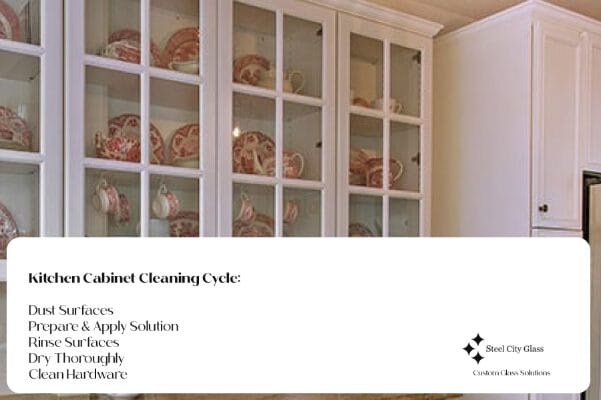How To Clean Kitchen Cabinets Like a Pro

How To Clean Kitchen Cabinets: Key Takeaways
- The best way to clean kitchen cabinets depends on the material they are made of
- For wood cabinets, use dish soap and warm water and wipe immediately to avoid moisture damage
- For painted cabinets, apply mild detergent and avoid abrasive tools to prevent chipping and streaks
- Keep white cabinets bright and fresh with regular dusting and baking soda paste
- Clean greasy cabinets with a vinegar-water mix or dish soap
- Basic supplies for cleaning kitchen cabinets include microfiber cloths, dish soap, vinegar, baking soda, and a soft sponge
- To keep kitchen cabinets in top shape, don’t use harsh chemicals, be careful with water, and test cleaners before use
The global household cleaners market is booming. It’s expected to reach $41.15 billion in 2025, with $8 billion made by the United States alone.
These numbers show people care about keeping their homes clean. And this includes kitchen cabinets.
In this article, we’ll break down:
- How to clean kitchen cabinets
- What supplies you need
- Common mistakes to avoid
How To Clean Kitchen Cabinets
Exposed to grease, fingerprints, and grime, kitchen cabinets can present a real cleaning challenge. Not when you know how to do it (and we’re here to share what exactly works).
Wood Cabinets
Giving your kitchen a warm and inviting feel, wood cabinets become a real challenge when it comes to cleaning as it’s very easy to damage their natural grain and finish.
- In a small bowl, add a few drops of mild dish soap and warm water and stir it gently.
- Dip a soft cloth into the mixture, wring it out well, and gently move along the wood grain.
- For sticky or greasy spots, apply a mix of equal parts vinegar and warm water and let it sit for several minutes.
- Dry immediately as moisture can warp or discolor the wood surface.
- Use a soft toothbrush to clean handles and decorative moldings where grime tends to collect.
Painted Cabinets
Traditional or modern in design, painted cabinets need special care to protect them from chipping, streaking, or faded color.
- Combine warm water with a small amount of gentle detergent.
- Wipe cabinet doors and drawer fronts, focusing on handles as they can be real dirt magnets.
- Go over the same areas with a clean, damp cloth to remove any leftover soap, which can dull paint.
- Avoid anything abrasive like scrub pads or rough sponges as they can scratch the finish.
White Cabinets
White cabinets make any kitchen look spacious and bright. Until they are no longer white but covered with specks of dirt. How to keep their crisp, clean look without damaging the surface?
- Wipe cabinets down with a dry microfiber cloth to remove dust or surface dirt, which can turn to smears during deeper cleaning.
- Mix baking soda and water until it forms a spreadable paste, you’ll be surprised it can work wonders on stains.
- Spread the paste on stains and let it sit for about 5–10 minutes, that’ll be enough to lift the grime.
- Clean the paste with a damp cloth, rinsing thoroughly to avoid residue buildup.
- Dry with a soft towel to bring back that crisp, white look you fell in love with.
Greasy Cabinets
If your cabinets are near the stove, grease is inevitable. The cleaning challenge? To remove the oily layer and keep the finishes intact.
- Fill a spray bottle with equal parts of white vinegar and warm water, an instant solution for dissolving grease.
- Sprinkle directly onto greasy spots and leave for 2-3 minutes to break down the oils.
- Wipe the grease away with a clean, soft sponge.
- For tough grease, use dish soap or a small amount of baking soda directly on the sponge.
- Rinse the area with clean water and dry.
Materials You’ll Need for Cleaning Kitchen Cabinets
Cleaning your kitchen cabinets doesn’t require a special arsenal of tools. To do the job, you’ll need:
- Microfiber cloths
- Soft sponge
- Dish soap
- White vinegar
- Baking soda
- Warm water
- Spray bottle
- Soft toothbrush (for hardware and crevices)
- Commercial cleaner (If you’re not a fan of home-made cleaning methods)

Common Mistakes To Avoid
Even with the best efforts, cleaning your cabinets can lead to unpleasant surprises if you don’t know what to steer clear of.
Using Harsh Chemicals
Strong cleaners like ammonia or bleach can damage the finishes, discoloring and stripping paint, and even destroy wood over time.
Skipping the Dry-Off Step
When cabinets don’t dry immediately, moisture seeps into joints or layers, causing swelling and warping. Mildew growth is also possible, putting you and your loved ones’ health at risk.
Scrubbing Too Hard
Hard scrubbing, especially when done with abrasive pads, can scratch the surfaces and damage protective layers.
Not Considering Hardware
Dirty handles, knobs, and hinges are not just an aesthetic issue. They collect grime and bacteria, which can affect anything you touch, from coffee mugs to food products.
Using Too Much Water
Excess water doesn’t necessarily mean better cleaning. It’s rather a risk, as water can go into cracks and edges of wooden or laminated cabinets, compromising their structural integrity.
Cleaning in Direct Sunlight
When cleaners dry before you have time to clean the surface properly, they can leave hard-to-remove streaks or residue.
Not Testing Cleaners
Depending on their components, cleaners can discolor or damage your cabinet surface. Make sure you test them in an area which is not visible.

Looking for Custom Cabinet Glass Solutions? Call Steel City Glass
Founded in 2000, Steel City Glass offers custom glass solutions for residential and commercial projects across Maryland, Virginia, and Washington D.C.
Thinking about upgrading your cabinets?
Our cabinet glass options:
- Come in various designs to match any decor style and personal preferences.
- Give your kitchen (or bathroom) a clean and airy look.
- Help you highlight what you want to show and conceal what you don’t.
- Are easy to use and maintain, giving you more time for your hobby or loved ones.
- Are crafted precisely to fit the cabinetry you already have, refreshing its look in an instant.
Considering glass for other areas in your home or office? Steel City Glass has got you covered. Check out our glass panels, swinging and sliding enclosures, mirrors, and glass shelves.
Everything comes with top quality materials, expert installation, and a comprehensive warranty.
️
How To Clean Kitchen Cabinets: FAQs
How can I prevent grease buildup?
To prevent accumulation of grease, install a quality range hood and use it while cooking. Use a vinegar solution to wipe down cabinets; it’s an excellent option to prevent grease hardening.
Can I polish my cabinets after cleaning?
Absolutely. Once your cabinets are clean and dry, consider using a polish.
- For wooden cabinets, use a wood-safe furniture polish.
- For painted surfaces, use a non-abrasive polish.
Do cabinet materials require professional cleaning?
You can consider professional cleaning if you have high-gloss acrylic, decorative glass, or special woodwork. Pro services can be needed if your cabinets are damaged or heavily soiled.
How often should I clean my kitchen cabinets?
Clean your kitchen cabinets every 1-2 weeks. Give them a deeper clean every few months.
Can I use Magic Erasers for cleaning my cabinets?
Magic Erasers can be abrasive and damaging to your cabinet’s surfaces. Test them first in an inconspicuous spot.
What’s the best way to clean cabinet handles and knobs?
For handles and knobs, use a toothbrush and a soap-water or water-vinegar solution.


